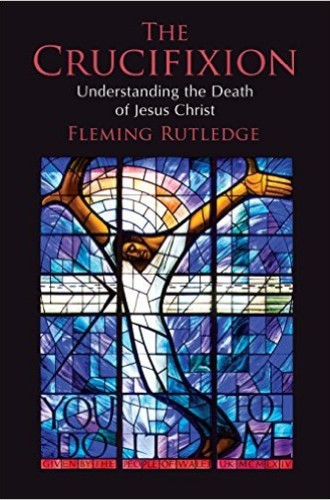Crux of the matter
Preacher Fleming Rutledge’s magnum opus is many things. It is an examination and rethinking of virtually all the major ways in which the death of Christ has been interpreted. It is also an argument that the how of Jesus’ death—the ghastly and dehumanizing ordeal of crucifixion—matters. But perhaps more than either of these, Rutledge’s book is a protest. It is a protest against what might be termed Christianity lite: against the many contemporary iterations of the Christian faith, both conservative and liberal, that don’t have much in the way of theological depth and seriousness—iterations that trade a rich, world-shaking, challenging faith for what seems only a mess of trivia.
The Crucifixion is also an extended protest against the failure to take seriously evil and sin—that is, to take seriously the world in which we live. Implicit in her argument is this thesis: a Christian faith that does not face and come to grips with radical evil does not deserve to be taken seriously.
Read our latest issue or browse back issues.
Early in her study, Rutledge observes that “personal engagement with the cross is difficult and painful, but leaders of congregations will have a hole in the center of their ministry without it.” She is right. Preachers who engage the apparently negative are not only doing so in a culture that is thoroughly committed to the upbeat and positive, but they are likely aware of the complexity of preaching and teaching about something that is both central and controversial. It is easy to get it wrong, and hard to get it right.
Don’t conservative and evangelical churches regularly preach the cross and the crucifixion? Yes, they do. But they often reduce these themes to formulaic, even mechanistic interpretations of their meaning, related only to individuals and their fate after death. Moreover, as Rutledge argues persuasively, such proclamations are often theologically incoherent, doing violence to the trinitarian nature of God and rendering the God now separated from Jesus Christ into a monster.
Perhaps partly in reaction to the predominance of such reductive and misleading interpretations of the crucifixion by conservatives and evangelicals, other parts of the church—mainline, liberal, and progressive congregations and their preachers—have had less and less that is substantive to say about the crucifixion. Pelagianism, ever knocking at the mainline door, sidesteps the cross to emphasize Jesus’ good works and his role as a moral exemplar and spiritual guide. Then proclamation tends to become telling stories about Jesus rather than preaching Christ crucified. In some mainline church settings, the crucified One is portrayed as just another innocent victim of the empire, not as the One whose death constituted God’s redemptive disruption of the world.
One of Rutledge’s crucial contributions is her reconsideration of Anselm, in which she shows that neither liberals nor conservatives have him right. Both camps have rendered Anselm far more simplistic, less nuanced, and less pastoral than he was. On more than one occasion Rutledge quotes Anselm’s rejoinder to his interlocutor, Boso, “You have not yet considered the weight of sin,” implying that this is also true of much contemporary American interpretation. Whatever else one may say of Anselm, he did take seriously the weight of sin.
After discussing Anselm, Rutledge takes up what she calls biblical motifs for understanding and interpreting the crucifixion. The use of the word motif is important. Too often interpretations of the death of Christ are described as theories, but in Rutledge’s view, a theory is far too tidy and rational for the layered ways the crucifixion is witnessed in scripture. The term motif is more fluid and suggestive, and it allows for the ways in which scripture is in dialogue with itself.
The Christus Victor motif reflects the apocalyptic theological orientation that decisively undergirds the entire book. Some of Rutledge’s most important themes derive from this perspective. She is influenced here by a number of New Testament scholars, including Ernst Käsemann and J. Louis Martyn (she studied with Martyn at New York’s Union Theological Seminary). Most of all Rutledge draws from the apostle Paul to convey an understanding of the crucifixion and resurrection as the apocalyptic novum—God’s decisive intervention in which the new age began.
Two of the many themes that apocalyptic theology contributes to an understanding of the crucifixion are particularly significant: sin and divine agency. Rutledge understands Sin and Death (she capitalizes them) as the twin ruling powers that hold the world and fallen humanity in their grip. Sin is not merely the misdeeds of individuals. Sin is a power and a realm that enslaves all human beings. What is required is not simply correction but deliverance. God and fallen human beings are not the only players on the field of life. The active powers of Sin and Death are there too. In the incarnation, God in Christ invaded the enemy’s turf—a perspective that casts a different light on Christmas.
This leads to the second particularly significant theme, divine agency. In the apocalyptic perspective, God is the primary actor. Salvation depends not on human beings getting it right, but on God’s action—God’s decisive intervention to encounter and disarm the powers of sin and death and to rectify what has been put out of joint. Rutledge stresses that God has done and is doing something we cannot do for ourselves.
In at least one quarter of American life, emphasis on these themes makes perfect sense: the world of addiction and recovery. Addiction is a matter not simply of personal error, but of being in the grip of a demonic power that wills one’s destruction. Many recovering addicts understand and confess their powerlessness over addiction and their need for and reliance on a higher power. This sounds remarkably like apocalyptic theology and Paul’s gospel. For Paul we are all addicts, all slaves of sin. The real reason mainline Christianity tends to be averse to both Paul and the cross may lie here: we doubt that we are sinners, and we are pretty sure we don’t need saving, thanks just the same.
Rutledge’s subtitle is Understanding the Death of Jesus Christ, and her work goes a long way toward advancing such understanding. But there is a more ancient sense of the word understanding that I suspect she would also welcome: we stand under something that we cannot fully see or grasp. Rutledge helps those who preach and those who listen not only to understand the meaning and significance of the crucifixion, but also to stand under it in awe and devotion.







